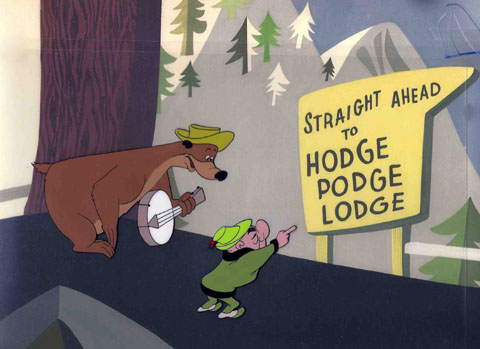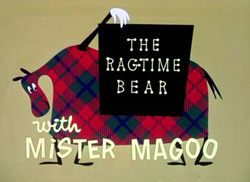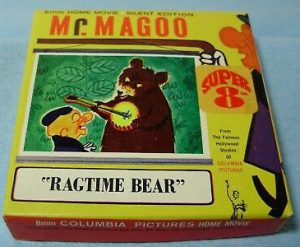
Looking through various stuff thats scanned here, I’m sometimes really taken aback by how much better an HD scan can look than what I consider really good standard def versions. Not always, but today’s short falls in that category – and looks really dandy in hd – with lots of details you wouldn’t see other than a good ol’ fashioned screening, on a theatre screen. Remember those days?
 Preparing things at Thunderbean. While still shepherding several other projects out the door, I’m happy to see things getting shored up in additional ways as I reluctantly hand over many duties completely to make the little company run much better. It’s admittedly hard to do, but will allow things to work as I concentrate on mastering all this stuff. Besides working on the releases we’re already doing, one of the upcoming big plans is to figure out how to actually buy a scanner to be able to scan many more things, for Thunderbean as well as other small producers.
Preparing things at Thunderbean. While still shepherding several other projects out the door, I’m happy to see things getting shored up in additional ways as I reluctantly hand over many duties completely to make the little company run much better. It’s admittedly hard to do, but will allow things to work as I concentrate on mastering all this stuff. Besides working on the releases we’re already doing, one of the upcoming big plans is to figure out how to actually buy a scanner to be able to scan many more things, for Thunderbean as well as other small producers.
The launch of the new Thunderbean Shop (thunderbeanshop.com) has already started to help in organizing. There’s a page noting the status on various projects as well as new ‘special’ discs. There’s even a new one this week.

Now — onto today’s cartoon:
I have a few favorite cartoons from UPA, and The Ragtime Bear (1949) is among them. There’s always unusual elements in this period, introducing more stylized elements of design as well as film language. From the first stylized shot of the film into the first shots of Magoo and Waldo, unusual elements present themselves. Magoo breaks the third wall on his first line in the film, forcing the heretofore nonexistent announcer or narrator to answer back! All musical elements vanish for this exchange, including an out-of-focus POV shot of Magoo trying to read. Introducing a character by his disability may never have been done before in a cartoon, much less a crabby old man as a main character.
 This scene is followed by unusual overlap in character voices, much more conversational and closer to something that might appear in a play rather that would usually appear in any scripted animated film. This technique continues into the lodge scene—and while it’s strikingly unusual for a late 40s cartoon, it became pretty standard in Hubley’s later independent work—and shows up in other Magoo cartoons. Art Babbitt’s lovely animation of Waldo strumming away at his banjo is some of my favorite stuff that has ever appeared in any UPA cartoon.
This scene is followed by unusual overlap in character voices, much more conversational and closer to something that might appear in a play rather that would usually appear in any scripted animated film. This technique continues into the lodge scene—and while it’s strikingly unusual for a late 40s cartoon, it became pretty standard in Hubley’s later independent work—and shows up in other Magoo cartoons. Art Babbitt’s lovely animation of Waldo strumming away at his banjo is some of my favorite stuff that has ever appeared in any UPA cartoon.
There’s beautiful design work throughout this film. Design and color are credited to Bill Hurtz, Herb Klynn and Jules Engel, and what wonderful design team leads they are. Animators Pat Matthews, Rudy Larriva and Willy Pyle round out the animation credits here, and I’m sure many of you can recognize their shots. The Moose on the wall always reminds me of the much-later Bullwinkle design, and of course Hurtz likely designed it. Magoo’s fall and splat are especially painful in this short, especially in the pose they’ve left him in after splatting! The elements of appealing design and posing are quite good, especially on our bear friend. The film also features some pretty unusual scoring, consisting of Banjo leading the orchestration. Is there any other cartoon that does that?
 Mr. Magoo can’t hold onto his design terribly well in this first short. He changes in each new scene. The ski sequence features, at one point, a much cuter Magoo, doing a little victory dance before holding his side in pain. This looks like Babbitt’s work to me as well; I especially like his cute little feet and roundness of design here. These elements clearly won out as he became more standardized. In the last sequence (where he ‘kills’ Waldo!) Magoo’s design changes pretty drastically, with each version having some appeal.
Mr. Magoo can’t hold onto his design terribly well in this first short. He changes in each new scene. The ski sequence features, at one point, a much cuter Magoo, doing a little victory dance before holding his side in pain. This looks like Babbitt’s work to me as well; I especially like his cute little feet and roundness of design here. These elements clearly won out as he became more standardized. In the last sequence (where he ‘kills’ Waldo!) Magoo’s design changes pretty drastically, with each version having some appeal.
John Hubley’s solid direction brings in a good picture without peppering it too much with high sensibilities. This cartoon, along with the other 40s shorts, attempt to take mainstream ‘standard’ industry elements for a framework and add to that the studio’s already somewhat established design ideas. From viewing their pre- Columbia shorts, its clear they backed away a little to a more mainstream approach. I imagine Columbia was happy with this if they weren’t directly responsible for that decision. It wouldn’t be too much longer before the studio went fully in with their full range of design sensibilities, leading to a much more comfortable balance.
One could argue that Warner Brothers actually treaded much of this same ground *first* in production design experimentation. A big difference is that they managed to keep their non-stylized character designs working with stylized background elements. There’s various experimentation throughout the 40s with various production designs in all the units. Their production design through the 50s settles on some comfortable design ideas that rarely lead the direction of the film or the timing of shots or characters, but rather contribute mostly to the feel rather than the film language itself. The best shorts from UPA (in the early 50s) often treat the design elements as a part of the story, altering the framework of direction to highlight them. The Ragtime Bear gives just a hint as to where they were going.
Have a good week everyone- and make sure to watch in HD.

A Ragtime Bear model sheet with the film’s original title “Strike Up The Banjo”


 Steve Stanchfield is an animator, educator and film archivist. He runs Thunderbean Animation, an animation studio in Ann Arbor, Michigan and has compiled over a dozen archival animation DVD collections devoted to such subjects at Private Snafu, The Little King and the infamous Cubby Bear. Steve is also a professor at the College for Creative Studies in Detroit.
Steve Stanchfield is an animator, educator and film archivist. He runs Thunderbean Animation, an animation studio in Ann Arbor, Michigan and has compiled over a dozen archival animation DVD collections devoted to such subjects at Private Snafu, The Little King and the infamous Cubby Bear. Steve is also a professor at the College for Creative Studies in Detroit.






















What happened to the reissuing of Yuletide Flickers?
“The film also features some pretty unusual scoring, consisting of Banjo leading the orchestration. Is there any other cartoon that does that?”
Not to the same extent, but I can think of a few that have prominent banjo solos. In “The Booze Hangs High” (1930), Bosko plays a banjo solo by plucking the tines of a pitchfork, as a family of ducks hop rhythmically to the music. I can’t identify the tune; it’s a nice, leisurely waltz melody.
In “Bosko’s Holiday” (1931), Bosko has an actual banjo, on which he plays the song “Hullabaloo” from the 1930 Warner Bros. musical “Dancing Sweeties” — while driving along in his convertible! When a string breaks, he replaces it with a mouse’s tail; and after he arrives at Honey’s house and all the strings on his banjo snap at once, the mouse gives him the raspberry and storms off.
Finally, there’s “Yankee Doodle Daffy” (1943), in which Daffy Duck demonstrates to talent agent Porky Pig how his client, Sleepy Lagoon, is going to “wow ’em” with a banjo solo — here, a virtuoso version of the college march “Frat”.
All of these solos are played on the tenor banjo, a four-stringed instrument tuned in fifths and played with a flat pick, as opposed to the five-stringed bluegrass banjo, tuned to a G major chord and plucked with three finger picks, heard in most of “The Ragtime Bear”. I have a feeling that the tune Waldo plays at the beginning of the cartoon was done using a banjolele, a fad of the 1920s, like a small banjo but with four strings tuned like a ukulele. Either that, or it’s a five-string with a capo way up the neck and played with a flat pick.
The music for “The Ragtime Bear” is by Lloyd G. Del Castillo (1893-1992), one of the last surviving silent film organists. He founded a school for theatre organists in Boston, had a long career as an organist in radio and television, and wrote regularly for an organ journal. His only film credits are for about a dozen UPA cartoons. I’d like to know who the banjoist on the soundtrack was: the sour notes and other effects indicate that the banjo music was recorded specifically for this cartoon, not taken from stock recordings.
RobGems68 Wrote:
One major notable thing in this first Mr.Magoo cartoon compared to later episodes: Magoo is actually one MEAN S.O.B. in this cartoon compared to the nicer, more clumsier Magoo he would eventually become. He’s so cruel, that he threatens Waldo with a rifle after having the heartache of nearly losing him by mistake with a misguided fake death with a dirty old bear rug shot up with holes enough to kill him. John Hubley actually preferred this early version of Magoo as opposed to the later “softened up” version of Magoo developed by Pete Burness in attempt by Columbia Pictures to make Magoo more “family friendly” by making him the lead breadwinner of UPA’s cartoon shorts. This weaker, friendlier Magoo continued on over the years since long after Columbia stopped distributing their shorts in 1959, and the television era took over.
RobGems68 Wrote:
One major notable thing in this first Mr.Magoo cartoon compared to later episodes: Magoo is actually one MEAN S.O.B. in this cartoon compared to the nicer, more clumsier Magoo he would eventually become. He’s so cruel, that he threatens Waldo with a rifle after having the heartache of nearly losing him by mistake with a misguided fake death with a dirty old bear rug shot up with holes enough to kill him. John Hubley actually preferred this early version of Magoo as opposed to the later “softened up” version of Magoo developed by Pete Burness in attempt by Columbia Pictures to make Magoo more “family friendly” by making him the lead breadwinner of UPA’s cartoon shorts. This weaker, friendlier Magoo continued on over the years since long after Columbia stopped distributing their shorts in 1959, and the television era took over.
So much fun animation in this short! Love how Babbitt plays around with Waldo’s legs the same way he did with Goofy back at Disney. I believe he also did the shot of Magoo confronting “Waldo” for the first time for playing the banjo, judging from his shuffling walk. And amazingly, much of this wild action is on twos, and yet it doesn’t look it. Magoo’s design was really all over the place; my favorite is the close-up when he says “Waldo! You’re alive!”, which makes him look older than he’s ever been.
RobGems68 Wrote:
Re: Paul Groh:
I always wondered as a kid who that mystery banjo picker was too on the soundtrack. It most certainly wasn’t Pete Seeger.
In this viewing I really noticed the Mickey-like ears on both the Ragtime Bear and the Bear Rug. Could this have been a subtle dig at Disney by Babbitt (or Hubley or Larriva)?
Yes, this embryonic Magoo would be unrecognizable to those brought up on the TV cartoons. No “Oh, Magoo- you’ve done it again.” Backus does the Popeye-esque adlibs from the beginning, but he made Quincy much gruffer. It’s hilariously timed, yet disturbing how upon giving Waldo his banjo back, he abruptly turns sinister. (“But if you play one note, I’ll BLAHHHST you!”)
Magoo’s fall and splat are pretty gruesome, and so is the bear hugging the desk clerk to what appears is his death.
Honestly, I feel like they were already softening the character when Hubley was still at the studio (see “Fuddy Duddy Buddy”).
I’m told the tenor or plectrum banjo part was played by well known banjoist in 1949 George Formby, but the five string banjo part being played is still a mystery. Some say it was Pete Seeger. Pete was a friend of John Hubley the animator who did some of the Magoo cartoons and was into labor organizing like Seeger was. So???